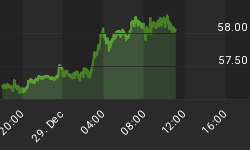Here is an extract from commentary posted at Another look at the 1970s model During 2002 and the first half of 2003 we would regularly show a chart comparing the performance of the AMEX Gold BUGS Index (HUI) from its November-2000 bottom with the performance of the Barrons Gold Mining Index (BGMI) from its January-1972 bottom. The chart was interesting because it showed that the gold-stock bull market that began in 2000 was following a very similar path to the one that began in 1972. If the HUI of today had continued to follow the BGMI of the early 1970s it would have reached a major peak towards the end of June 2003. When June 2003 arrived, though, it was apparent to us that gold stocks were not close to a major peak. We therefore stopped showing this chart comparison because the gold-stock bull market of today was clearly diverging from its 1970s counterpart. However, provided we don't take the chart comparison too literally, that is, provided we don't have the unrealistic expectation that the current bull market will mimic every significant twist and turn of the 1970s bull market, there might still be some validity to the 1970s model. The reason we say this is that although gold stocks reached a major peak in August of 1974 (the 1974 peak was not exceeded until the second half of 1979), the trend remained positive until around July of 1975 (the July-1975 peak wasn't far below the August-1974 peak). On the below chart, which compares the 1970s BGMI with the HUI of today, the BGMI's secondary peak in July of 1975 would correspond with May of 2004. We are re-introducing the 1970s model at this time because a major peak in the gold stocks in May of 2004 meshes with what we see happening in other markets. In particular and as further explained below, it fits with the strong tendency of the gold sector to peak some time AFTER the Dow Industrials Index has reached a major peak of its own.
When the medium-term outlook for the gold price is bullish, as it is now, gold stocks usually do well during the initial stages of any substantial downturn in the broad stock-market but get hit hard when the broad market begins to decline at an accelerated pace. In other words, the intermediate-term trend for gold stocks should remain positive until the Dow has entered the accelerated phase of its next decline. However, after the stock market has rallied as strongly as it has done over the past 14 months it would be atypical for it to peak and then immediately fall to pieces. Rather, an initial decline followed by a 'test' of the peak would be a more likely outcome. So if the Dow makes an important peak in January, as per our current forecast, then a March 'test' of the peak would be normal with an accelerated decline not commencing until April at the earliest.
Current Market Situation
There is evidence, such as the breakdown in the HUI/gold ratio, to indicate that the HUI has already peaked for this cycle. However, regardless of whether this is or isn't the case it now looks like the positive trend in the gold sector is going to extend into April-May of 2004. This might mean that the HUI makes a lower peak over the coming months while many of the junior gold stocks, as well as some of the majors that didn't really participate in this year's rally (for example, Harmony Gold Mining and Gold Fields Limited), make new highs.
In the short-term (the next 1-2 months), the correction that began in early December is likely to continue. The HUI has some resistance at around 245 and some rather important short-term support at 220.

By the way, if you are planning to take profits in a stock and you know that the stock has a 70% probability of trading at a higher price in three months time, should you take your profits now or wait for three months? The correct answer is: it depends on the expected magnitude of the upside relative to the downside risk. For example, if you assess that the stock has a 70% chance of rising 5% over the next three months and a 30% chance of falling 25% then you should take the profits now.
The above question is relevant to the gold sector's current situation because although there is a reasonable chance that gold stocks, as a group, will trade above today's levels within the next several months, most of the major North American gold stocks and a few of the junior/mid-tier producers do NOT look attractive from a risk/reward perspective. In all likelihood they will trade higher, but at their current prices the downside risk exceeds the probable upside.
















